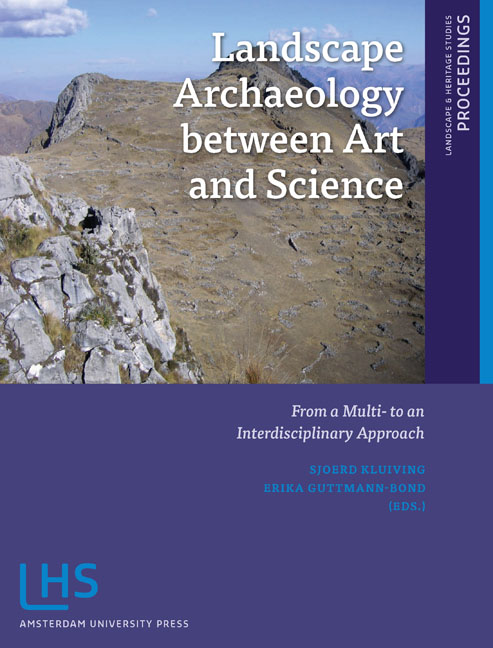Book contents
- Frontmatter
- Contents
- Preface
- Introduction: LAC2010: First International Landscape Archaeology Conference
- THEME 1 HOW DID LANDSCAPE CHANGE?
- THEME II IMPROVING TEMPORAL, CHRONOLOGICAL AND TRANSFORMATIONAL FRAMEWORKS
- THEME III LINKING LANDSCAPES OF LOWLANDS TO MOUNTAINOUS AREAS
- THEME IV APPLYING CONCEPTS OF SCALE
- THEME V NEW DIRECTIONS IN DIGITAL PROSPECTION AND MODELLING TECHNIQUES
- THEME VI HOW WILL LANDSCAPE ARCHAEOLOGY DEVELOP IN THE FUTURE?
- Miscellaneous Endmatter
5.5 - Using LiDAR-Derived Local Relief Models (LRM) as a new tool for archaeological prospection
Published online by Cambridge University Press: 21 January 2021
- Frontmatter
- Contents
- Preface
- Introduction: LAC2010: First International Landscape Archaeology Conference
- THEME 1 HOW DID LANDSCAPE CHANGE?
- THEME II IMPROVING TEMPORAL, CHRONOLOGICAL AND TRANSFORMATIONAL FRAMEWORKS
- THEME III LINKING LANDSCAPES OF LOWLANDS TO MOUNTAINOUS AREAS
- THEME IV APPLYING CONCEPTS OF SCALE
- THEME V NEW DIRECTIONS IN DIGITAL PROSPECTION AND MODELLING TECHNIQUES
- THEME VI HOW WILL LANDSCAPE ARCHAEOLOGY DEVELOP IN THE FUTURE?
- Miscellaneous Endmatter
Summary
ABSTRACT
High-resolution Digital Elevation Models (DEM) based on airborne LiDAR have emerged as a valuable new data source in archaeology. While such data are becoming increasingly available on a regional to national scale, their potential is far from being fully utilised. One field in which improvements can be expected is the optimisation of data processing with the goal of extracting anthropogenic features for archaeological prospection. Until recent years, however, most archaeological applications of LiDAR have been limited to the visual interpretation of the DEM. In this case, the detection of potential archaeological features depends to a large degree on the chosen illumination angles. Here, a data processing approach is presented which produces Local Relief Models (LRM) from LiDAR-derived high-resolution DEM. The LRM represents local, small-scale elevation differences after removing the large-scale landscape forms from the data. The LRM greatly enhances the visibility of small-scale, shallow topographic features irrespective of the illumination angle and allows their relative elevations as well as their volumes to be directly measured. This makes the LRM an improved basis for spatially extensive archaeological prospection over a wide range of landscapes. The LRM raster map of local positive and negative relief variations can be used for the mapping and prospecting of archaeological features such as burial mounds, linear and circular earthworks, sunken roads, agricultural terraces, ridge and furrow fields, kiln podia and mining sites. This approach is currently being used in a project aimed at the spatially complete archaeological mapping and prospection of Baden-Württemberg, covering an area of 35,751 km2. The goal is the verification and extension of the existing archaeological data base. An object-based local relief vector layer is produced as a by-product; however, due to the common agglutination of natural and anthropogenic features this cannot be efficiently used for archaeological prospection at present.
KEYWORDS
LiDAR, Local Relief Model, LRM, archaeological prospection, Baden-Württemberg, Germany
INTRODUCTION
The federal state Baden-Württemberg in south-western Germany is rich in archaeological heritage from the Palaeolithic onwards. Numerous Neolithic, Bronze and Iron Age, Roman, Merovingian, medieval and early modern sites make Baden-Württemberg a region of great archaeological importance (cf. LAD 2009, for an overview of recent archaeological research in Baden-Württemberg).
- Type
- Chapter
- Information
- Landscape Archaeology between Art and ScienceFrom a Multi- to an Interdisciplinary Approach, pp. 369 - 378Publisher: Amsterdam University PressPrint publication year: 2012
- 1
- Cited by



